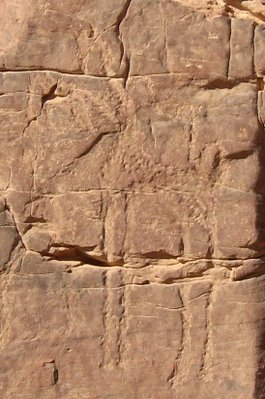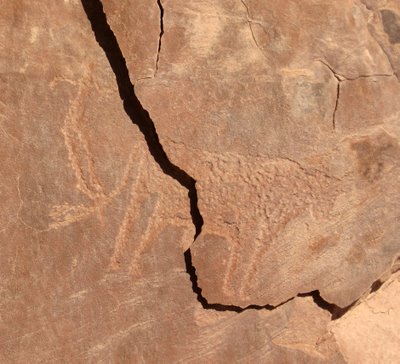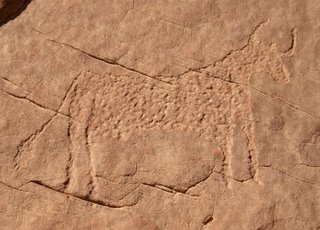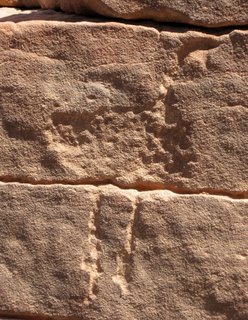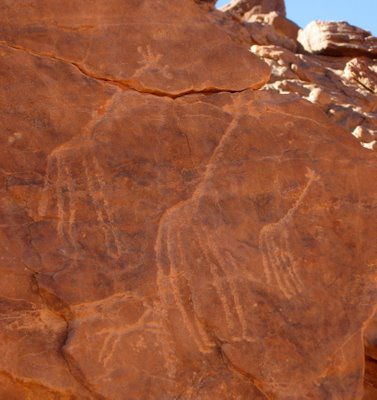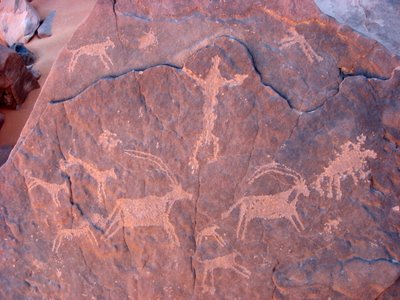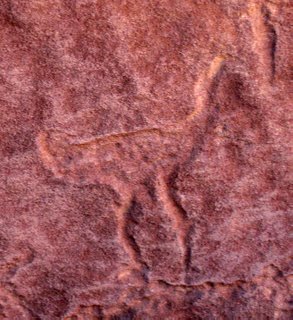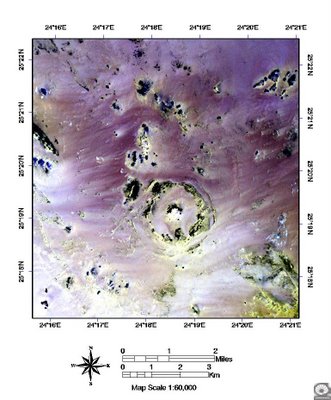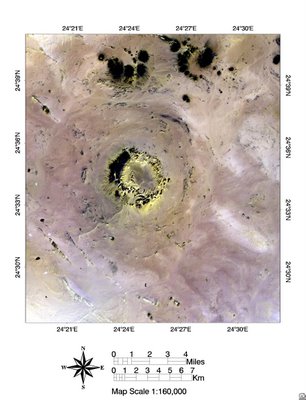Sand seas exist in at least 18 important locations in the world, four of these in the North African Sahara (Vivian, 2002). The Calanscio Sand Sea in Libya and Great Sand Sea of Egypt begin as one near the northern Mediterranean coast and at the latitude Siwa and Jalo they break up in two. They form the second biggest sand sea in the world after the Rub al Khali (empty quarter) in southern Saudi Arabia. The Great Sand Sea alone covers 72,000 km2, almost 1.5 times the size of Holland!
The Great Sand Sea is steadily moving south and has begun to infiltrate the northern eastern corner of the Gilf Kebir. Dunes are already encroaching on Gebel Almasy, and it is clear that even a plateau the size of Gilf Kebir will eventually not be able to stop the dunes.
After a brief encounter with the awesome Great Sand Sea in Siwa, we fell in love with this magnificent stretch of desert. Our recent expedition is probably one of the most challenging possible in Great Sand Sea; crossing the ±350 km of sand sea from east to west and back from west to east. It is a route rarely taken, and we were told that a Paris-Dakar rally champion attempted it once and had to give up (but we did not know this beforehand…). We are very proud that we made it, thanks to our excellent guide and friend Mohammed. We drove ten days, nearly 1600 km off road, with no place to resuply fuel, water or food on the way.
The Great Sand Sea is a complex of various dune forms and sand sheets. A lot of the early classification of windblown sand was actually done in the Great Sand Sea by Major Ralph Bagnold (1896-1990), a British desert explorer who formed the Long Range Desert Group in WWII (Kelly, 2002; Bagnold, 1941; Pannekoek 1976). Below some of the main components are described.
Simply said, dunes form when wind erodes sand on one side and deposits it on the other side. A slip face is where the sand falls down when wind has transported it over the dune crest. As such, these are as steep as dry sand grains can physically be sacked up (this the angle of repose, generally about 30° for dry sand). Because of their steepness, you can drive/fall off slip faces, but you cannot drive up slip faces. Also if you fail to drive exactly parallel to the slope of a slip face you car can get into a roll in a matter of seconds. This makes dune driving probably the most dangerous form of off-road driving, and therefore adrenaline levels can get pretty high!
Parallel straight dunes or Seif or sword dunes are formed by unidirectional wind. In the Great Sand Sea moving Seif dunes sit astride, relatively unmoving 2 km wide whaleback dunes (Vivian, 2002). While the long Seif dunes move, the base, the whaleback dunes remain in place (Vivian, 2002). Some whaleback dunes have multiple Seif dune crests with multiple slip faces to cross, something you cannot see from the foot of the dune. In the Sand Sea these are parallel to the prevailing NNW wind direction, and some are as high as 100m and as long as 145 km! The parallel dune slip faces of the Great Sand Sea generally face eastwards. So, crossing east to west is very difficult. Despite the fact that between the dunes ground is often nearly void of sand, the only way to get across is driving over them (Vivian, 2002). Trying to go around is often impossible (Vivian, 2002). In order drive over them in the wrong direction, you have to drive through narrow gaps without a slip face. Thanks to Mohammed’s preparation with detailed satellite map reconnaissance (he studied the maps for 6 nights, 3 hours per evening) and his extensive experience we found most corridors for crossing smoothly. If you get it wrong and you cross at the wrong point you can get stuck or in a far more dangerous situation very quickly.
Parallel wavy dunes or barchan dunes are crescent-shaped with a width equal to their length and a single curved slip face, roughly perpendicular to the wind direction. They can go as high as 100m and extent for 400m (Vivian, 2002). They can move very fast, as much as 19 m per year, and change direction when the wind pattern changes (Vivian, 2002). At the tips of a crescent –shaped “mother” dune new “child” barchan dunes form, eventually forming a barchan dune field. These are extremely hard to cross as they change rapidly and their curved slip faces can easily roll your car if you approach them the wrong way.
Star dunes are created when the wind often changes direction, and have the shape of a star in plan view. They are rare in the Great Sand Sea, and usually found in isolation. Because of the irregular shape of the crests, they are very hard to climb or cross by car. We saw (and climbed) one on an earlier trip near Siwa.
Sand sheets are flat hard sheets of sand that go on for many kilometres. Here you can drive 80-90 km/h easily. However, sometimes there are major soft patches. If you slow down to much, and you do not have enough momentum to cross them, you get stuck. Because they are flat there is no direction you can drive in to get the help of gravity to get unstuck. Therefore, it is almost impossible to pick up speed and momentum again to drive out. You could end up driving out sand plate by sand plate (these are only 1.5 m long); a slow and lengthy process. Fortunately, when never got into this situation, but we where close a couple of times.
References
Bagnold, R.A. 1941. The physics of blown sand and desert dunes. London, Methuen, 265p.
Kelly, S., 2002. The hunt for Zerzura –The Lost Oasis and the Desert War. Published by John Murray, London, 302p.
Pannekoek, A.J. 1976. Algemene Geologie. Tjeenk Willink, Groningen, 531p.
Vivian, C., 2002. The Western Desert of Egypt. The american University in Cairo Press. Cairo, 426p.
Monday, January 15, 2007
Thursday, January 11, 2007
The climate changed over time
At the end of the Pliocene (Tertiary) period, the Sahara had generally a warm and humid climate. But during the Quarternary period between 1,8 million and 10,000 years ago, there were five major ice ages and an equal number of intermediate periods. Some areas were savannah with trees and grasses, others steppe, depending on the dryness. Cold and humid periods interchanged and dryness became part of the Sahara area. Around 20,000 years ago, an intense dryness began, which would last for 10,000 years. This was a consequence of the last big ice age on earth, the Würm ice age.
From ±14,000 to 13,000 years ago it started to rain again occasionally, and the Sahara was getting greener. This was also the start of the Neolithic period, with the development of pottery, domestication of animals (starting with catching rather than killing wild animals) and agriculture (starting with grinding wild wheats). At this time, the Nile valley suffered from massive floodings. From ±10,000 year ago the wet period really started and the Sahara became inhabited once again (start of the Holocene). At that time it is generally 2 to 4 degrees colder than at present. The mountainous Gilf Kebir served as a giant water reservoir, and attracted people and animals to its valleys. The earliest rock art is from this period. Between 8,000-7,500 years ago there was relatively dry period, forcing people and animals to live close together and as a result the Cattle period began. The wet period lasted until 5,000 years ago, and the current extreme drought started at about 4,000 years ago, gradually ending the inhabitation of the Gilf Kebir valleys and most of the Sahara. This introduction was compiled from Vivian (2002), Bourseiller (2004), and Scott (2004).
References
Bourseiller, P., 2004. Sahara - de wereld van de woestijn. Uitgeverij Lannoo N.V., Tielt, 424p.
Scott, C., 2004. Sahara Overland - A route and planning guide. Trailblazer publications, Hindhead, 672p.
Vivian, C., 2002. The Western Desert of Egypt. The american University in Cairo Press. Cairo, 426p.
From ±14,000 to 13,000 years ago it started to rain again occasionally, and the Sahara was getting greener. This was also the start of the Neolithic period, with the development of pottery, domestication of animals (starting with catching rather than killing wild animals) and agriculture (starting with grinding wild wheats). At this time, the Nile valley suffered from massive floodings. From ±10,000 year ago the wet period really started and the Sahara became inhabited once again (start of the Holocene). At that time it is generally 2 to 4 degrees colder than at present. The mountainous Gilf Kebir served as a giant water reservoir, and attracted people and animals to its valleys. The earliest rock art is from this period. Between 8,000-7,500 years ago there was relatively dry period, forcing people and animals to live close together and as a result the Cattle period began. The wet period lasted until 5,000 years ago, and the current extreme drought started at about 4,000 years ago, gradually ending the inhabitation of the Gilf Kebir valleys and most of the Sahara. This introduction was compiled from Vivian (2002), Bourseiller (2004), and Scott (2004).
References
Bourseiller, P., 2004. Sahara - de wereld van de woestijn. Uitgeverij Lannoo N.V., Tielt, 424p.
Scott, C., 2004. Sahara Overland - A route and planning guide. Trailblazer publications, Hindhead, 672p.
Vivian, C., 2002. The Western Desert of Egypt. The american University in Cairo Press. Cairo, 426p.
Wednesday, January 10, 2007
Rock art in the northern Gilf Kebir
Rock art is abundantly found in the whole of the Sahara, the most prolific site in all of Africa is perhaps Wadi Mathendous in Libya (Vivian, 2002). North African rock art overall can be categorised into 5 periods (Vivian, 2002; Scott, 2004):
The wadis of Gebel Uweinat are the sites where most of the rock art has been found, varying from engravings to paintings with white, red and yellow colours. In these wadis, in addition to the engravings and paintings, tool-sharpening marks and pottery have occasionally been found.
During our journey, we crossed the Great Sea of Sand and reached the northern Gilf Kebir from the eastern side. There we passed Gebel Almasy and crossed difficult stretches of dunes to the other side to reach Wadi Hamra. This wadi is one of the three wadis that Count Ladislaus Almasy claimed to form the legendary lost oasis of Zerzura (more information about this will be added to this website soon). This wadi is special in that it has reddish sand and a fair number of trees, to contrast the dark Gilf Kebir rocks, which makes it stunningly beautiful.
In this wadi, we visited three sites with rock art. One was on a hill in a side branch from the main wadi, with good views to all directions, possibly a good hunters spot to watch the animals from. Probably the site is the same as discovered by Friedrich Berger and party in 1998 (www.fjexpeditions.com).
Another site was further along the wadi, in another arm of the wadi, at a site where the wadi branched, again with good views in all directions (Rochert, 1935). This site was the richest in rock art.
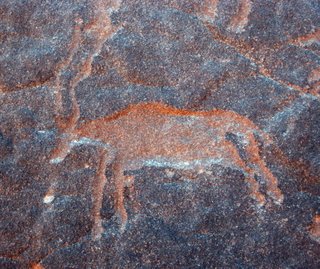
A third site was along the wadi wall, not far from the 1st site, on our way out on the eastern side of the wadi, with very weathered engravings mostly low on the rock face. Probably the site is the same as discovered by Giancarlo Negro & party, 1991 (www.fjexpeditions.com).
All sites have only engravings, and the second site has also numerous tool-sharpening marks. There was neither pottery nor spearheads nor axes found, but we saw a possible grinding stone at the first site.
Most engravings show animals, such as giraffes, gazelles or antilopes with long or curley horns, cows or oxes with short horns, dogs, ostriches and possibly one elephant. Only some engravings represented human figures.
Although most of the rock art in Uweinat and other wadis of the Gilf Kebir are from the Cattle period, we think that these engravings are from the hunting period and therefore likely to be older than 7,500 years and younger than 10,000. Giraffes and gazelles are mostly seen but there are also scenes that look like hunting scenes with dog-like figures running around them. Cows, indicative for the cattle period, are relatively rare.
This section on rock art will be updated these coming weeks with more on rock art in Uweinat and southern wadis of the Gilf Kebir.
References
Scott, C., 2004. Sahara Overland - A route and planning guide. Published by Trailblazer publications, Hindhead, 672p.
Vivian, C., 2002. The Western Desert of Egypt. The american University in Cairo Press. Cairo, 426p.
- The Bubalus or Hunting period (engravings) from 12,000 to 7,500 years ago.
- The Archaic or Pre-pastoralist (or Roundhead) period (painting) from roughly 10,000 to 6,000 years ago.
- The Cattle period (both engravings and paintings, cattle dominates depicted animals) from 7,500 to 4,500 years ago.
- The Horse and Chariot period from roughly 3,200 to 1,200 years ago (horses were introduced in 1,200 BC/3,200 years ago).
- The Camel period from 2,000 to 1,000 (or present) years ago (camels were introduced around 450 BC / 2,450 years ago).
The wadis of Gebel Uweinat are the sites where most of the rock art has been found, varying from engravings to paintings with white, red and yellow colours. In these wadis, in addition to the engravings and paintings, tool-sharpening marks and pottery have occasionally been found.
During our journey, we crossed the Great Sea of Sand and reached the northern Gilf Kebir from the eastern side. There we passed Gebel Almasy and crossed difficult stretches of dunes to the other side to reach Wadi Hamra. This wadi is one of the three wadis that Count Ladislaus Almasy claimed to form the legendary lost oasis of Zerzura (more information about this will be added to this website soon). This wadi is special in that it has reddish sand and a fair number of trees, to contrast the dark Gilf Kebir rocks, which makes it stunningly beautiful.
In this wadi, we visited three sites with rock art. One was on a hill in a side branch from the main wadi, with good views to all directions, possibly a good hunters spot to watch the animals from. Probably the site is the same as discovered by Friedrich Berger and party in 1998 (www.fjexpeditions.com).
Cow © Corine & Jurriaan
Ostrich © Corine & Jurriaan

Ostrich © Corine & Jurriaan
A third site was along the wadi wall, not far from the 1st site, on our way out on the eastern side of the wadi, with very weathered engravings mostly low on the rock face. Probably the site is the same as discovered by Giancarlo Negro & party, 1991 (www.fjexpeditions.com).
All sites have only engravings, and the second site has also numerous tool-sharpening marks. There was neither pottery nor spearheads nor axes found, but we saw a possible grinding stone at the first site.
Most engravings show animals, such as giraffes, gazelles or antilopes with long or curley horns, cows or oxes with short horns, dogs, ostriches and possibly one elephant. Only some engravings represented human figures.
Although most of the rock art in Uweinat and other wadis of the Gilf Kebir are from the Cattle period, we think that these engravings are from the hunting period and therefore likely to be older than 7,500 years and younger than 10,000. Giraffes and gazelles are mostly seen but there are also scenes that look like hunting scenes with dog-like figures running around them. Cows, indicative for the cattle period, are relatively rare.
This section on rock art will be updated these coming weeks with more on rock art in Uweinat and southern wadis of the Gilf Kebir.
References
Scott, C., 2004. Sahara Overland - A route and planning guide. Published by Trailblazer publications, Hindhead, 672p.
Vivian, C., 2002. The Western Desert of Egypt. The american University in Cairo Press. Cairo, 426p.
Friday, January 05, 2007
Silica Glass
One major goal of our recent expedition across the Great Sea of Sand was to visit the area where the mysterious Silica Glass rocks are found. Below is an attempt to unravel the current knowledge about this material. This is work in progress. As we discover more about the material we will update this blog.
 The book Désert Libyque reports that the first known mention of Silica Glass in the Libyan desert was made by envoys of Hagg Hussein of Kufra in 1846 (Vivian, 2002). It was reported two years later to the European world by Fresnel, the French consul, in the Bulletin de l'Institut de Géographie de Paris (Vivian, 2002). It was also known by Prof Karl Zittel of the Gerhard Rohlfs (1831-1896) expedition of 1874 and by Ludwig Borchardt, who wrote about it in 1929 (Vivian, 2002). However, knowledge about this geological phenomenon really starts when Patrick Clayton (1896-1962), a British surveyor for the Egyptian Geological Survey, announced his discovery in December 1932 (Kelly, 2002).
The book Désert Libyque reports that the first known mention of Silica Glass in the Libyan desert was made by envoys of Hagg Hussein of Kufra in 1846 (Vivian, 2002). It was reported two years later to the European world by Fresnel, the French consul, in the Bulletin de l'Institut de Géographie de Paris (Vivian, 2002). It was also known by Prof Karl Zittel of the Gerhard Rohlfs (1831-1896) expedition of 1874 and by Ludwig Borchardt, who wrote about it in 1929 (Vivian, 2002). However, knowledge about this geological phenomenon really starts when Patrick Clayton (1896-1962), a British surveyor for the Egyptian Geological Survey, announced his discovery in December 1932 (Kelly, 2002).
Pat Clayton (Kelly, 2002)
He claimed to be the first white man to cross the Great Sand Sea from ‘Ain Dalla to the Libyan border, and he built the 5 feet high landmark "Big Cairn" to commemorate it. From Big Cairn, Clayton turned east and then south to the northern end of the Gilf Kebir.
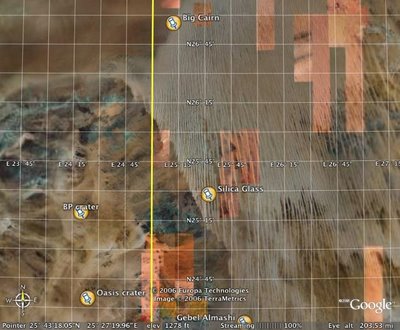 Google Earth satelite image of the Great Sand Sea
Google Earth satelite image of the Great Sand Sea
(yellow line is the Egyptian-Libyan border; the field with white north-south lineaments on the right is the Great Sand Sea; the dark patch at the bottom near the border is the northern Gilf Kebir)
As he was driving for 95 miles among the dunes of the Great Sand Sea, he heard his tyres crunch on something that wasn't sand. It turned out to be large pieces of marvellously clear, yellow-green Silica Glass scattered on the gravel streets between the dunes (Kelly, 2002). In fact, this wasn't just any ordinary glass, but ultra-pure glass that was an astonishing 98% silica.
In 1934, the Geological Society of Egypt launched an expedition to bring L.J. Spencer, minerals expert of the British Museum, to the site (Vivian, 2002). They collected and analysed the glass for nine days, and believed it to exist in a limited area of 130 km north-south by 53 km east-west (Vivian, 2002). Later it was found that Silica Glass is concentrated in two areas, rather than one. One area is oval-shaped; the other is a circular ring, 6 km wide and 21 km in diameter. The ring's wide centre is devoid of the glass.
An article by Giles Wright in the British science magazine New Scientist (July 10, 1999), entitled "The Riddle of the Sands", says that Silica Glass a.k.a. Libyan Desert Glass is the purest natural Silica Glass ever found. Over a thousand tonnes of it are strewn across hundreds of kilometres of bleak desert. Some of the chunks weigh 26 kilograms, but most Silica Glass exists in smaller, angular pieces.
In our journey we crossed the Great Sand Sea as well from east to west, but much further south than Clayton did. We went directly east to Gebel Almasy, a prominent plateau named by the Hungarian explorer count Ladislaus Almasy (1895-1951). From Gebel Almasy we crossed the last dune rows westward to reach the northern Gilf. From here, we went north along the dune corridors in opposite direction of Clayton’s 1932 journey.
Scientific speculation continues to this day as to the origin of this material. An extraterrestrial meteorite impact that fused the sand is a common theory. Sand metamorphoses (i.e. alters) similarly to pale green glass following nuclear explosion (Scott, 2004). However, there is no evidence for a meteorite impact crater rim at the location. One speculation was that it could have been formed by the close passage of the tail of a comet that did not hit the earth (Kelly, 2002). Another hypothesis was that it is of volcanic origin (Vivian, 2002). In the 1980s Ulrich Jux proposed the theory of an anchient lake, super-saturated with silica that left silica depostits in the dried-up cracks of the lake bed, which form glass through a complicated chemical reaction (Vivian, 2002). The absence of a crater as well as the presence of partially fused glass fragments and organic matter in some samples supports this theory (Scott, 2004). There is a general tendency, however, to consider Silica Glass as an impactite, meaning that it was formed by sudden melting and rapid cooling of terrestrial rocks as a result of the impact of large cosmic bodies (Abed, 1998). The best proof for the meteorite hypothesis came when a Egyptian-Italian expedition found fragments of iron and stone meteorites and some fine grains of coesite and stishovite (i.e. meteoric materials) in 1993 (Abed, 1998). More recently, fractured sand pebbled and grains as well as weathered fragments of octahedritic and chondritic meteorites were identified in the area (Abed 1998). Scientist agree that the age of the formation of silica glass is in the Oligocene, more precisely at ± 29 million years old (Bigazzi and de Michele 1997 and Horn et al 1997)
Absence of craters?
In December 1971, an expedition went to the Gilf Kebir to see if some of the craters there also contained Silica Glass (Vivian, 2002). They did confirm that some of these craters where formed by the impact of extraterrestrial bodies, but they found no Silica Glass (Vivian, 2002). There was a suggestion by Abate et al. (1997ab, 1999) that the Silica Glass in Egypt could be related to the BP and Oasis impact craters in Libya. The BP Structure is located on N 25° 19', E 24° 20'. It is 2 km in diameter and less than 120 million years old. (http://www.unb.ca/passc/ImpactDatabase).
The Oasis Structure is located on N 24° 35', E 24° 24'. It is 18 km in diameter and also less than 120 million years old (http://www.unb.ca/passc/ImpactDatabase).
Schaaf and Mueller Sohnius (2002) performed isotope analysis on Silica Glass samples and they concluded that Silica Glass is an impact related natural glass of still unknown target material (target material is the rock type before impact). However, they excluded the theories of Abate (1997ab, 1999) as they have proven that isotope ratios in Silica Glass are generally incompatible with those of the sandstone host rock at the Oasis and BP craters.
They also compared the isotope ratios of Silica Glass to the local bedrock of Cretaceous sandstone of the Nubian group, more precisely the Upper Cretaceous Coniacian Saad Formation. They used Rubidium-Strontium and Samarium-Neodymium isotope analysis and saw that these two isotope ratios were not rehomogenised (i.e. the clock was not reset) during the impact event. This enabled them to determine the age of the target rock to be Pan-African (± 540 million years old). They concluded that the most likely target rock was a sandy matrix derived from Precambrian crystalline basement rock ruling out Cretaceous sandstones of the Nubian group as precursors.
What is it used for?
The scarab turned out to be made of Silica Glass, far more precious than all other stones in Tut's pectoral jewel (Vivian, 2002). This indicated that the ancient Egyptians knew about the Great Sand Sea and its Silica Glass, and given the central position in the jewel, they probably knew how rare and precious it was (Vivian, 2002). This new finding is quite astonishing considering the fact that Tutankhamen is from the 18th dynasty and reigned from ± 1332-1322 BC and camels where only introduced by the Persian king Cambyses of the 27th dynasty who reigned between ±525-522 BC (Baines and Malek, 2002). And even with camels Cambyses is known to have lost an army of 50 000 soldiers in the Great Sea of Sand. To this date nobody has found a trace of this army. Crossing the Great Sand Sea is difficult and dangerous with 4x4s or camels, but impossible on foot. How did the ancient Egyptians collect the silica glass across several hundred kilometres of hostile sand dunes?
 The book Désert Libyque reports that the first known mention of Silica Glass in the Libyan desert was made by envoys of Hagg Hussein of Kufra in 1846 (Vivian, 2002). It was reported two years later to the European world by Fresnel, the French consul, in the Bulletin de l'Institut de Géographie de Paris (Vivian, 2002). It was also known by Prof Karl Zittel of the Gerhard Rohlfs (1831-1896) expedition of 1874 and by Ludwig Borchardt, who wrote about it in 1929 (Vivian, 2002). However, knowledge about this geological phenomenon really starts when Patrick Clayton (1896-1962), a British surveyor for the Egyptian Geological Survey, announced his discovery in December 1932 (Kelly, 2002).
The book Désert Libyque reports that the first known mention of Silica Glass in the Libyan desert was made by envoys of Hagg Hussein of Kufra in 1846 (Vivian, 2002). It was reported two years later to the European world by Fresnel, the French consul, in the Bulletin de l'Institut de Géographie de Paris (Vivian, 2002). It was also known by Prof Karl Zittel of the Gerhard Rohlfs (1831-1896) expedition of 1874 and by Ludwig Borchardt, who wrote about it in 1929 (Vivian, 2002). However, knowledge about this geological phenomenon really starts when Patrick Clayton (1896-1962), a British surveyor for the Egyptian Geological Survey, announced his discovery in December 1932 (Kelly, 2002).Pat Clayton (Kelly, 2002)
He claimed to be the first white man to cross the Great Sand Sea from ‘Ain Dalla to the Libyan border, and he built the 5 feet high landmark "Big Cairn" to commemorate it. From Big Cairn, Clayton turned east and then south to the northern end of the Gilf Kebir.
 Google Earth satelite image of the Great Sand Sea
Google Earth satelite image of the Great Sand Sea(yellow line is the Egyptian-Libyan border; the field with white north-south lineaments on the right is the Great Sand Sea; the dark patch at the bottom near the border is the northern Gilf Kebir)
In 1934, the Geological Society of Egypt launched an expedition to bring L.J. Spencer, minerals expert of the British Museum, to the site (Vivian, 2002). They collected and analysed the glass for nine days, and believed it to exist in a limited area of 130 km north-south by 53 km east-west (Vivian, 2002). Later it was found that Silica Glass is concentrated in two areas, rather than one. One area is oval-shaped; the other is a circular ring, 6 km wide and 21 km in diameter. The ring's wide centre is devoid of the glass.
An article by Giles Wright in the British science magazine New Scientist (July 10, 1999), entitled "The Riddle of the Sands", says that Silica Glass a.k.a. Libyan Desert Glass is the purest natural Silica Glass ever found. Over a thousand tonnes of it are strewn across hundreds of kilometres of bleak desert. Some of the chunks weigh 26 kilograms, but most Silica Glass exists in smaller, angular pieces.
In our journey we crossed the Great Sand Sea as well from east to west, but much further south than Clayton did. We went directly east to Gebel Almasy, a prominent plateau named by the Hungarian explorer count Ladislaus Almasy (1895-1951). From Gebel Almasy we crossed the last dune rows westward to reach the northern Gilf. From here, we went north along the dune corridors in opposite direction of Clayton’s 1932 journey.
Scientific speculation continues to this day as to the origin of this material. An extraterrestrial meteorite impact that fused the sand is a common theory. Sand metamorphoses (i.e. alters) similarly to pale green glass following nuclear explosion (Scott, 2004). However, there is no evidence for a meteorite impact crater rim at the location. One speculation was that it could have been formed by the close passage of the tail of a comet that did not hit the earth (Kelly, 2002). Another hypothesis was that it is of volcanic origin (Vivian, 2002). In the 1980s Ulrich Jux proposed the theory of an anchient lake, super-saturated with silica that left silica depostits in the dried-up cracks of the lake bed, which form glass through a complicated chemical reaction (Vivian, 2002). The absence of a crater as well as the presence of partially fused glass fragments and organic matter in some samples supports this theory (Scott, 2004). There is a general tendency, however, to consider Silica Glass as an impactite, meaning that it was formed by sudden melting and rapid cooling of terrestrial rocks as a result of the impact of large cosmic bodies (Abed, 1998). The best proof for the meteorite hypothesis came when a Egyptian-Italian expedition found fragments of iron and stone meteorites and some fine grains of coesite and stishovite (i.e. meteoric materials) in 1993 (Abed, 1998). More recently, fractured sand pebbled and grains as well as weathered fragments of octahedritic and chondritic meteorites were identified in the area (Abed 1998). Scientist agree that the age of the formation of silica glass is in the Oligocene, more precisely at ± 29 million years old (Bigazzi and de Michele 1997 and Horn et al 1997)
Absence of craters?
In December 1971, an expedition went to the Gilf Kebir to see if some of the craters there also contained Silica Glass (Vivian, 2002). They did confirm that some of these craters where formed by the impact of extraterrestrial bodies, but they found no Silica Glass (Vivian, 2002). There was a suggestion by Abate et al. (1997ab, 1999) that the Silica Glass in Egypt could be related to the BP and Oasis impact craters in Libya. The BP Structure is located on N 25° 19', E 24° 20'. It is 2 km in diameter and less than 120 million years old. (http://www.unb.ca/passc/ImpactDatabase).
The Oasis Structure is located on N 24° 35', E 24° 24'. It is 18 km in diameter and also less than 120 million years old (http://www.unb.ca/passc/ImpactDatabase).
Schaaf and Mueller Sohnius (2002) performed isotope analysis on Silica Glass samples and they concluded that Silica Glass is an impact related natural glass of still unknown target material (target material is the rock type before impact). However, they excluded the theories of Abate (1997ab, 1999) as they have proven that isotope ratios in Silica Glass are generally incompatible with those of the sandstone host rock at the Oasis and BP craters.
They also compared the isotope ratios of Silica Glass to the local bedrock of Cretaceous sandstone of the Nubian group, more precisely the Upper Cretaceous Coniacian Saad Formation. They used Rubidium-Strontium and Samarium-Neodymium isotope analysis and saw that these two isotope ratios were not rehomogenised (i.e. the clock was not reset) during the impact event. This enabled them to determine the age of the target rock to be Pan-African (± 540 million years old). They concluded that the most likely target rock was a sandy matrix derived from Precambrian crystalline basement rock ruling out Cretaceous sandstones of the Nubian group as precursors.
What is it used for?
The glass had been used in the prehistoric times to make knives and sharp-edged tools as well as other objects. However, such tools we did not find in our expedition.
In October 1998, Vincenzo de Michele of the Centro Luigi Negro was allowed to analyse a carved scarab, until then thought to be made of not-so-precious chalcedone, in Tutanchamen's pectoral jewelry found in his tomb (Vivian, 2002).
The scarab turned out to be made of Silica Glass, far more precious than all other stones in Tut's pectoral jewel (Vivian, 2002). This indicated that the ancient Egyptians knew about the Great Sand Sea and its Silica Glass, and given the central position in the jewel, they probably knew how rare and precious it was (Vivian, 2002). This new finding is quite astonishing considering the fact that Tutankhamen is from the 18th dynasty and reigned from ± 1332-1322 BC and camels where only introduced by the Persian king Cambyses of the 27th dynasty who reigned between ±525-522 BC (Baines and Malek, 2002). And even with camels Cambyses is known to have lost an army of 50 000 soldiers in the Great Sea of Sand. To this date nobody has found a trace of this army. Crossing the Great Sand Sea is difficult and dangerous with 4x4s or camels, but impossible on foot. How did the ancient Egyptians collect the silica glass across several hundred kilometres of hostile sand dunes?
References
Abate, B. Koeberl, C., Underwood, J.R., Reimold, W.U., Buchanan, P., Fisk, E.P. and Giegengack, R.F. 1997a. BP and Oasis impact structures, Libya: Preliminary petrographic and geochemical studies, and relation to Libyan desert glass (abstract). Lunar and Planetary Science XXVIII, pp. 1-2.
Abate, B. Koeberl, C., Underwood, J.R., Fisk, E.P. and Giegegack, R.F. 1997b. BP and Oasis impact structures, Libya, and their relation to Libyan desert glass: Petrography, geochemistry, and geochronology (abstract). Large Meteorite Impacts and Planetary Evolution,.
Abate, B., Koeberl, C., Kruger, F.J., and Underwood, J.R. 1999. BP and Oasis impact structures, Libya, and their relation to Libyan Desert Glass. In: Proceedings, Conference on Large Meteorite Impacts and Planetary Evolution (Eds. Dressler, B.O., and Sharpton, V.L.), Geological Society of America, Special Paper 339, 177-192.
Abed, W.T., 1998. The nother Egypt- travels in no-man’s land. Cairo, 242p.
Baines, J. and Malek, J., 2002. Atlas of Ancient Egypt-Revised Edition. The American University in Cairo Press, Cairo, 240p.
Bigazzi, G. and de Michele, V., 1997. New fission-track ages of Libyan Desert Glass. In Proceedings, Silica ’96, Meeting on Libyan Desrt Glass and related events (Ed. V. de Michele), pp. 49-57. Sahara, Pyramids, Milano, Italy.
Horn, P., Mueller-Sohnius D., Schaaf, P., Kleinmann, B., and Storzer, D, 1997. Potassium-Argon and fission track dating of Libyan Desert Glass, and Strontium- and Neodymium isotope constraints on its source rocks. In Proceedings, Silica ’96, Meeting on Libyan Desrt Glass and related events (Ed. V. de Michele), pp. 59-73. Sahara, Pyramids, Milano, Italy.
Kelly, S., 2002. The hunt for Zerzura –The Lost Oasis and the Desert War. Published by John Murray, London, 302p.
Schaaf, P.and Mueller-Sohnius, D., 2002. Strontium and neodymium isotopic study of Libyan Desert Glass: Inherited Pan-African age signatures and new evidence for target material. Meteorites and Planetary Science 37, 565-576p.
Scott, C., 2004. Sahara Overland - A route and planning guide. Published by Trailblazer publications, Hindhead, 672p.
Stoddert Gilbert, K., Holt, J.K., and Hudson, S. (editors), 1976. Treasures of Tutankhamun. Published by the Metropolitan Museum of Art, New York, 175p.
Vivian, C., 2002. The Western Desert of Egypt. The american University in Cairo Press. Cairo, 426p.
Wright, G. 1999. The Riddle of the Sands. New Scientist.
Abate, B. Koeberl, C., Underwood, J.R., Reimold, W.U., Buchanan, P., Fisk, E.P. and Giegengack, R.F. 1997a. BP and Oasis impact structures, Libya: Preliminary petrographic and geochemical studies, and relation to Libyan desert glass (abstract). Lunar and Planetary Science XXVIII, pp. 1-2.
Abate, B. Koeberl, C., Underwood, J.R., Fisk, E.P. and Giegegack, R.F. 1997b. BP and Oasis impact structures, Libya, and their relation to Libyan desert glass: Petrography, geochemistry, and geochronology (abstract). Large Meteorite Impacts and Planetary Evolution,.
Abate, B., Koeberl, C., Kruger, F.J., and Underwood, J.R. 1999. BP and Oasis impact structures, Libya, and their relation to Libyan Desert Glass. In: Proceedings, Conference on Large Meteorite Impacts and Planetary Evolution (Eds. Dressler, B.O., and Sharpton, V.L.), Geological Society of America, Special Paper 339, 177-192.
Abed, W.T., 1998. The nother Egypt- travels in no-man’s land. Cairo, 242p.
Baines, J. and Malek, J., 2002. Atlas of Ancient Egypt-Revised Edition. The American University in Cairo Press, Cairo, 240p.
Bigazzi, G. and de Michele, V., 1997. New fission-track ages of Libyan Desert Glass. In Proceedings, Silica ’96, Meeting on Libyan Desrt Glass and related events (Ed. V. de Michele), pp. 49-57. Sahara, Pyramids, Milano, Italy.
Horn, P., Mueller-Sohnius D., Schaaf, P., Kleinmann, B., and Storzer, D, 1997. Potassium-Argon and fission track dating of Libyan Desert Glass, and Strontium- and Neodymium isotope constraints on its source rocks. In Proceedings, Silica ’96, Meeting on Libyan Desrt Glass and related events (Ed. V. de Michele), pp. 59-73. Sahara, Pyramids, Milano, Italy.
Kelly, S., 2002. The hunt for Zerzura –The Lost Oasis and the Desert War. Published by John Murray, London, 302p.
Schaaf, P.and Mueller-Sohnius, D., 2002. Strontium and neodymium isotopic study of Libyan Desert Glass: Inherited Pan-African age signatures and new evidence for target material. Meteorites and Planetary Science 37, 565-576p.
Scott, C., 2004. Sahara Overland - A route and planning guide. Published by Trailblazer publications, Hindhead, 672p.
Stoddert Gilbert, K., Holt, J.K., and Hudson, S. (editors), 1976. Treasures of Tutankhamun. Published by the Metropolitan Museum of Art, New York, 175p.
Vivian, C., 2002. The Western Desert of Egypt. The american University in Cairo Press. Cairo, 426p.
Wright, G. 1999. The Riddle of the Sands. New Scientist.
Thursday, January 04, 2007
Fossil lightning, balls and tubes
On our journey through the Great Sand Sea we encountered fulgarites, fragile straws of fused sand. These fulgarites are formed when lightning hits, and the electrical energy is dispersed directly down into the arid sand. The centre of these tubes is hollow because the sand evaporated here due to the intense heat of the lightning beam, the rim consists of molten and fused sand, giving it a glassy appearance.
Some hematite concretions we found have similar tube like appearance. Hematite is an iron-based mineral, which leaves a red color when you scratch it (Heamos is blood in Greek, so hematite is blood rock). Because the hematite mineralised rock is stronger than its surrounding, wind erosion will nicely expose the concretions.
Some other concretions start around a nucleus and form round, often hollow, balls. The exact process of this mineralisation, and why it forms these odd shapes is difficult to unravel. One factor is slight differences in rock permeability, creating preferred pathways for mineral-rich fluids, influencing the shape of the concretions. Another factor is grain size. Areas with lower size grains in the rock (which translates in to a higher grain surface area) are places where minerals preferentially precipitate. Fossil root casts, or fossil borrows from animals that lived on the seafloor, can create tube like areas where permeability and grain size is different from the surrounding rock. With the odd balls and tubes we found, we could not determine if the factors mentioned above had an influence on the shape.
Some hematite concretions we found have similar tube like appearance. Hematite is an iron-based mineral, which leaves a red color when you scratch it (Heamos is blood in Greek, so hematite is blood rock). Because the hematite mineralised rock is stronger than its surrounding, wind erosion will nicely expose the concretions.
Some other concretions start around a nucleus and form round, often hollow, balls. The exact process of this mineralisation, and why it forms these odd shapes is difficult to unravel. One factor is slight differences in rock permeability, creating preferred pathways for mineral-rich fluids, influencing the shape of the concretions. Another factor is grain size. Areas with lower size grains in the rock (which translates in to a higher grain surface area) are places where minerals preferentially precipitate. Fossil root casts, or fossil borrows from animals that lived on the seafloor, can create tube like areas where permeability and grain size is different from the surrounding rock. With the odd balls and tubes we found, we could not determine if the factors mentioned above had an influence on the shape.
Subscribe to:
Posts (Atom)







